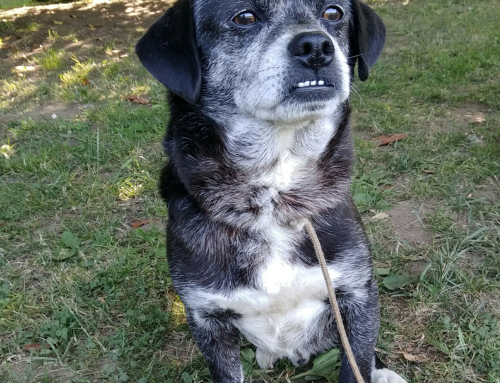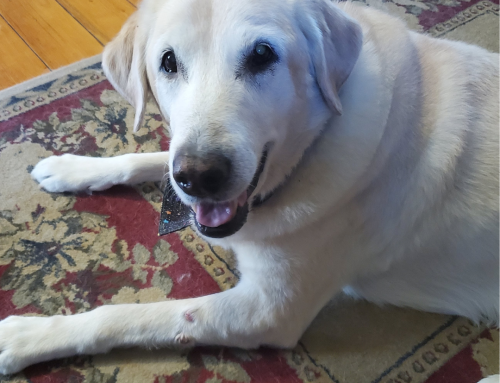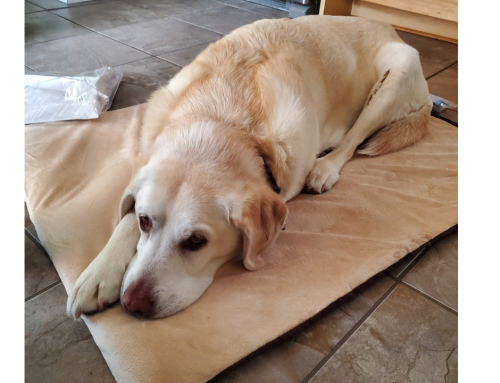Wobblers syndrome, more correctly called cervical spondylomyelopathy (or CSM for short), is a condition that affects the cervical (neck) spinal column in dogs. It’s more commonly recognized in younger large and giant breeds, such as Great Danes, Doberman Pinschers, and Irish Wolfhounds, although any breed can be affected.
In older dogs (middle-aged or seniors), Wobblers can be caused by degeneration and ageing changes in the spinal cord, which can lead to symptoms and possibly pain. This blog will more specifically focus on geriatric wobblers.

The cause of wobblers syndrome in younger dogs is not well understood, but genetics, nutritional factors, and trauma are believed to play a role.
While both young and old dog conditions share some similar symptoms and involve compression of the spinal cord in the neck region, they have different underlying causes and may require different treatment approaches. In general, geriatric wobblers syndrome is considered to have a better prognosis than wobblers syndrome, as it tends to progress more slowly and is less likely to require surgical intervention.
What changes in the spinal column lead to Wobblers?
There are two categories of changes:
- Disc associated – disc protrudes (i.e. “bulges”) into the spinal cord
- Osseous-associated – there is abnormal bone growth which narrows the spinal canal and reduces the space for the spinal cord
In either case, when structures start to come into contact with the spinal cord, the messages being relayed from the brain to the body become disrupted or cut-off leading to symptoms. Their is a widening of the spinal cord in the caudal (towards the tail) end of the cervical spine which is mismatched with a narrowing of the spinal canal (i.e. the space which the spinal cord travels through) leading to spinal cord impingement.
What are the signs of wobblers syndrome?
- Wobbly or unsteady hind end often worse when walking slow or on slippery flooring
- Possibly head down posture, especially during an acute flare-up
- Dragging of the hind legs
- Knuckling of the hind legs
- Weakness or paralysis of the hind legs which may progress to the front legs
- Lameness of a front leg
- Difficulty getting up from the ground
Wobblers syndrome often exhibits hind end symptoms before front leg symptoms because the information carried in the outer layer of the spinal cord controls the hind end and is impacted by impingement in the neck. In other words, that tract carrying the hind end information is less protected on the outer part of the spinal cord than the information for the front legs which is carried more internally in the spinal cord.

How is Wobblers syndrome diagnosed?
Wobblers syndrome in dogs can be diagnosed through a combination of physical examination, medical history, and diagnostic testing. Your primary veterinarian will start with a physical examination of your dog. They may suggest imaging such as an xray or even a CT or MRI. Your vet may also suggest blood tests to rule out other conditions that could be causing your dog’s symptoms, such as hypothyroidism. A referral to a veterinary neurologist may be recommended depending on the severity of symptoms.
What are the treatment options for wobblers syndrome?
Treatment depends on the severity of the symptoms. Cases with mild symptoms are managed with anti-inflammatory and pain medications. For severe cases, a referral to a specialist is warranted for a discussion about surgery. Surgery is aimed at decompressing the spinal cord. For more information about surgery, we suggest this resource.
Working with a rehabilitation therapist is recommended as they can use modalities (e.g. laser therapy) to reduce inflammation and pain, manual therapies to help with neck mobility and provide exercises to help with strength and stability.

I think my senior dog has Wobblers but my vet said it was just due to old age, is there anything I can do about it?
It’s always easy for many “old dog” symptoms to be brushed off. If you’ve been told that your dog is “just old” don’t accept it and seek more help. A canine rehab therapist can further assess your dog, especially their neck, to see if they have signs of Wobblers and work with you on a treatment plan. At Pawsitively Fit, we’ve seen many dogs who are likely dogs with geriatric wobblers. They have wobbly and weak back legs and neck pain that their owners often didn’t know they had. For many owners, it’s often a relief to know what is likely causing their dog’s symptoms and knowing that there are things that can be done to help their dog have a better quality of life.
Resources
Edge-Hughes, Laurie. “Geriatric Wobblers’ and Physiotherapy Management .” Four Leg Rehab Inc., 2013.
“Wobblers in Dogs Fact Sheet.” Davies Veterinary Specialists, 7 Apr. 2020, https://vetspecialists.co.uk/fact-sheets-post/wobblers-in-dogs-fact-sheet/.



